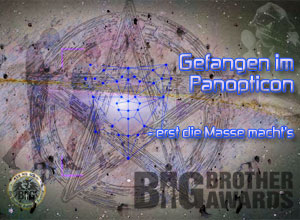

|
search / subscribe / upload / contact |
|
|
||
|
|
||
|
|
||
|
|
||
|
|
||
|
|
||
|
|
||
|
|
||
| RSS-Feed Depeschen | ||

|
||
Date: 1999-10-13
Korrektur: IPv6 Protokoll-.-. --.- -.-. --.- -.-. --.- -.-. --.- -.-. --.- -.-. --.- haben: es wurde der falsche Text attachiert und kausal damit nexiert. Die Privacy Concerns resultieren aus dieser Kernpassage des u.a. Texts aus dem Electronic Privacy Information Center. Any Comments welcome. "The IETF has designated 64 bits of the new space to contain EUI-64 format information, which is used to assign Ethernet addresses. That information, which is generally not transmitted outside a user's local area network, forms the basis of the privacy concerns raised by some observers of the IETF process. The EUI-64 information identifies the registered manufacturer of a NIC card and a user's 48-bit Ethernet address. This has led some critics to claim that every packet a user sends out onto the Internet using IPv6 will have the user's "fingerprints" on it. Unlike IP addresses under IPv4, which can be changed, IPv6 addresses will be permanently embedded in hardware. " -.-. --.- -.-. --.- -.-. --.- -.-. --.- -.-. --.- -.-. --.- A new protocol being developed by the Internet Engineering Task Force (IETF) has raised privacy concerns. Internet Protocol Version 6 (IPv6) is the "next generation" protocol designed by the IETF to replace the current version Internet Protocol (IPv4), which is now nearly twenty years old. IPv6 is intended to fix a number of problems in IPv4, such as the limited number of available IPv4 addresses. It would also add improvements in areas such as routing and network autoconfiguration. The new addressing structure, however, may mean that every packet can be traced back to each user's unique network interface card ID. Whereas IPv4 has a 32-bit address field, IPv6 has 128 bits of address space. The IETF has designated 64 bits of the new space to contain EUI-64 format information, which is used to assign Ethernet addresses. That information, which is generally not transmitted outside a user's local area network, forms the basis of the privacy concerns raised by some observers of the IETF process. The EUI-64 information identifies the registered manufacturer of a NIC card and a user's 48-bit Ethernet address. This has led some critics to claim that every packet a user sends out onto the Internet using IPv6 will have the user's "fingerprints" on it. Unlike IP addresses under IPv4, which can be changed, IPv6 addresses will be permanently embedded in hardware. In that respect, IPv6 raises many of the same issues that surrounded the launch of the Intel Pentium III, which contains a "Processor Serial Number" (PSN) that is capable of uniquely identifying the user of a particular computer. Both IPv6 and the PSN present potential challenges to online anonymity, which is a fundamental guarantee of both privacy and free expression on the Internet. Additional information on IPv6 is available at: http://www.ipv6.org/ Additional information on the Intel Pentium III PSN is available at: http://www.bigbrotherinside.org -.- -.-. --.- BIG BROTHER AWARDS AUSTRIA 1999 Fuer Lauschangreifer, Spitzelfirmen, Datenhaendler, gesetzlich ermaechtigte Ueberwacher Reichen Sie Ihre Nominierung ein: http://www.bigbrother.awards.at -.-. --.- -.-. --.- -.-. --.- -.-. --.- -.-. --.- -.-. --.- - -.-. --.- -.-. --.- -.-. --.- -.-. --.- -.-. --.- -.-. --.- edited by Harkank published on: 1999-10-13 comments to office@quintessenz.at subscribe Newsletter - -.-. --.- -.-. --.- -.-. --.- -.-. --.- -.-. --.- -.-. --.- |
|
|
|
| CURRENTLY RUNNING | |
q/Talk 1.Juli: The Danger of Software Users Don't Control

|
|
| !WATCH OUT! | |
bits4free 14.Juli 2011: OpenStreetMap Erfinder Steve Coast live in Wien

|
|

